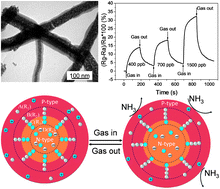Synergic effect within n-type inorganic–p-type organic nano-hybrids in gas sensors†
Abstract
This paper describes the exploration of a synergic effect within n-type inorganic–p-type organic nano-hybrids in gas sensors. One-dimensional (1D) n-type SnO2–p-type PPy composite nanofibers were prepared by combining the electrospinning and


 Please wait while we load your content...
Please wait while we load your content...